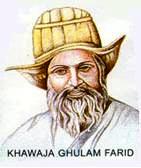"Rohi lagrri e sawni turt walaa hoteâ¦â¦ 
Makkalwadh Swadh do ro ro waat niharan
Disda yaar probhra baithi kaang uddaran"
Different Seraiki experts on Khwaja Farid, like Maulana Aziz-ur-Rehman, Noor Ahmad Faridi, Asif Khan and Mujahid Jatui have explained âMakkalwadh Swadhâ according to their capacity and approach.
Mujahid Jatuiâs explanation is right to much extent. I add some thing more to him.
Khwaja Sain was well informed about the languages and geography of Seraiki wasaib and it neighboring areas, as âMulk Malheerâ(Malir of Karachi), âMaru Thalraâ, Rohi Cholistanâ, Jaisalmirâ, âBikanirâ etc. most probably he had visited all the places.
 An extract from Major Ravertyâs book, âNotes on Afghanistan and Baluchistanâ published in AD 1878 page 452, about surveys conducted in AD 1780-88, help us understand the location of Makkalwadh Swadh.
â⦠and one kuroh (kos) south of it (kallurkot) is Naghari from which you go an other kuroh in the same direction to Noon, another to Umar Wali; and three in the direction of south-west to Suwad-Pur. Half a kuroh more brings you to Makkalwadh, previously mentioned in the account of Baluch tribe of Hut. Both the last named places are ancient towns, and the latter was, in olden times capital of Hut tribe. When Ismail Khan and other chiefs of Hut acquired considerable state and dignity, they abandoned the place, which had been their former dwelling place, and founded a large city on the other side of the river Sindh, and styled it the Derah of Ismail Khan. From that period these two towns began to go to decay, and were neglected; and now (AD 1878) are desolate. Up to this period of time the tract of country extending from Kalurkot to Darya Khan and from Dera of Ismail Khan to Paharpur (on both sides of Indus) they call it Makkalwadh.â
The above extract from an authentic scholar, cleary defines the location of âMakkadwadh Swadhâ. The old towns of Makkalwadh and Swadhpur have been completely washed away by the mighty Indus in the passage of time. In these places, there are now small towns of Shah Alam and Vastee Mai Roshan where people from Hote tribe still live and are closely related to their kinsmen across the Indus at Rangpur in Dera Ismail Khan. The legendary Punnu of Sassi was also a Hote from Kech&Makran and the Hote people here described originally had migrated from that area.
Author: Ijaz Bloach(admin)Â
